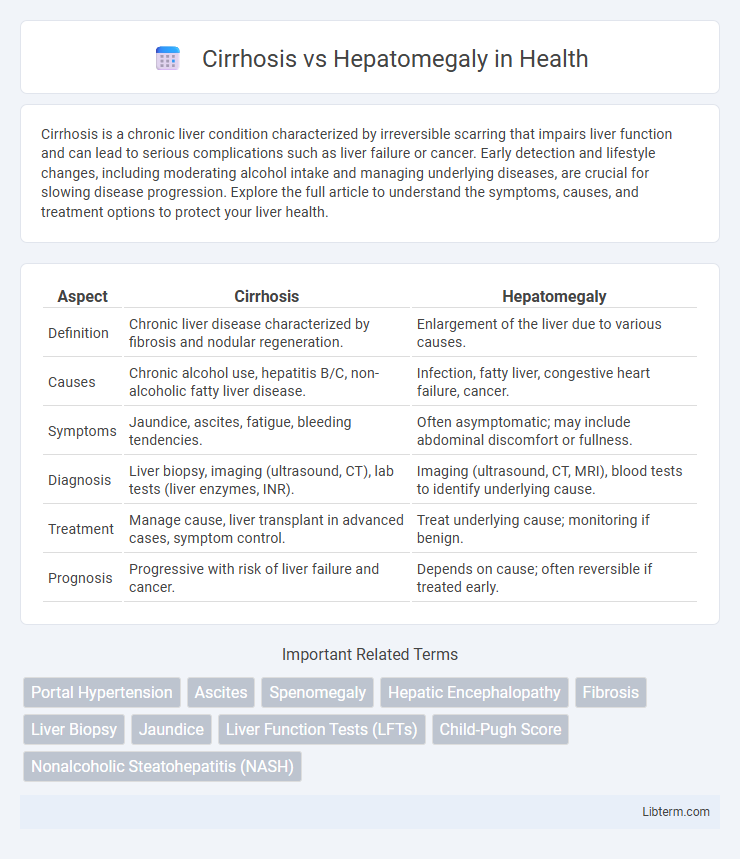Cirrhosis is a chronic liver condition characterized by irreversible scarring that impairs liver function and can lead to serious complications such as liver failure or cancer. Early detection and lifestyle changes, including moderating alcohol intake and managing underlying diseases, are crucial for slowing disease progression. Explore the full article to understand the symptoms, causes, and treatment options to protect your liver health.
Table of Comparison
| Aspect | Cirrhosis | Hepatomegaly |
|---|---|---|
| Definition | Chronic liver disease characterized by fibrosis and nodular regeneration. | Enlargement of the liver due to various causes. |
| Causes | Chronic alcohol use, hepatitis B/C, non-alcoholic fatty liver disease. | Infection, fatty liver, congestive heart failure, cancer. |
| Symptoms | Jaundice, ascites, fatigue, bleeding tendencies. | Often asymptomatic; may include abdominal discomfort or fullness. |
| Diagnosis | Liver biopsy, imaging (ultrasound, CT), lab tests (liver enzymes, INR). | Imaging (ultrasound, CT, MRI), blood tests to identify underlying cause. |
| Treatment | Manage cause, liver transplant in advanced cases, symptom control. | Treat underlying cause; monitoring if benign. |
| Prognosis | Progressive with risk of liver failure and cancer. | Depends on cause; often reversible if treated early. |
Definition of Cirrhosis
Cirrhosis is a chronic liver disease characterized by irreversible scarring and fibrosis that disrupts normal liver architecture and function. Hepatomegaly refers to an enlarged liver, which can result from various conditions, including cirrhosis, infections, or metabolic disorders. While cirrhosis specifically denotes progressive liver damage and impaired regeneration, hepatomegaly is a broader clinical finding without defined pathology.
Definition of Hepatomegaly
Hepatomegaly refers to an abnormal enlargement of the liver, detectable through physical examination or imaging techniques like ultrasound or CT scans. Unlike cirrhosis, which involves progressive liver scarring and impaired function, hepatomegaly indicates increased liver size without specifying the underlying cause, which may include infections, fatty liver disease, or congestive heart failure. Accurate diagnosis of hepatomegaly requires evaluating liver size alongside biochemical markers and patient history to differentiate it from other liver conditions such as cirrhosis.
Key Differences Between Cirrhosis and Hepatomegaly
Cirrhosis is a chronic liver disease characterized by fibrosis and irreversible scarring that impairs liver function, whereas hepatomegaly refers to an enlarged liver size without specifying underlying pathology. Cirrhosis typically results from long-term alcohol abuse, hepatitis B or C infections, or non-alcoholic fatty liver disease, leading to complications like portal hypertension and liver failure. Hepatomegaly can arise from various conditions such as infections, congestion, metabolic disorders, or malignancies and may be asymptomatic or a sign of underlying liver or systemic diseases.
Common Causes of Cirrhosis
Cirrhosis is primarily caused by chronic liver diseases such as hepatitis B and C infections, prolonged alcohol abuse, and nonalcoholic fatty liver disease (NAFLD). Hepatomegaly, referring to an enlarged liver, can result from various conditions like congestive heart failure, liver infections, and metabolic disorders, but it does not always indicate cirrhosis. Identifying common causes of cirrhosis, including viral hepatitis, alcohol-induced liver damage, and metabolic syndromes, is crucial for diagnosis and targeted treatment strategies.
Common Causes of Hepatomegaly
Hepatomegaly, or liver enlargement, commonly results from conditions such as fatty liver disease, viral hepatitis, and congestive heart failure, whereas cirrhosis is characterized by irreversible liver scarring often due to chronic alcoholism and hepatitis C infection. Hepatomegaly can also arise from metabolic disorders like glycogen storage diseases and infiltrative diseases such as amyloidosis or lymphoma. Understanding these causes is essential for distinguishing between reversible liver enlargement and the advanced fibrosis associated with cirrhosis.
Symptoms: Cirrhosis vs Hepatomegaly
Cirrhosis symptoms include jaundice, fatigue, easy bruising, and ascites due to liver scarring and impaired function. Hepatomegaly primarily presents as an enlarged liver that may cause abdominal discomfort or fullness without the extensive systemic symptoms seen in cirrhosis. Differentiating these conditions requires attention to signs of liver failure in cirrhosis compared to isolated liver enlargement in hepatomegaly.
Diagnostic Methods and Tools
Diagnostic methods for cirrhosis primarily involve liver biopsy, elastography, and serum biomarkers to assess fibrosis severity and liver function. Hepatomegaly diagnosis relies on physical examination, abdominal ultrasound, and CT or MRI imaging to evaluate liver size and detect underlying causes. Both conditions require liver function tests and imaging modalities to differentiate structural changes and guide appropriate treatment strategies.
Treatment Options and Management
Cirrhosis treatment centers on managing symptoms, slowing disease progression, and preventing complications through medications like antivirals, diuretics, and lifestyle changes including alcohol cessation and nutritional support. Hepatomegaly management varies based on the underlying cause, such as treating infections, controlling heart failure, or addressing fatty liver disease with weight loss and metabolic control. Regular monitoring and supportive care are essential in both conditions to improve patient outcomes and quality of life.
Complications and Prognosis
Cirrhosis often leads to severe complications such as liver failure, portal hypertension, ascites, hepatic encephalopathy, and increased risk of hepatocellular carcinoma, significantly impacting patient prognosis with high morbidity and mortality rates. Hepatomegaly, while indicative of liver enlargement due to various causes like infection, fatty liver disease, or congestive heart failure, may have a more variable prognosis depending on the underlying condition and often presents fewer immediate life-threatening complications. Early detection and management of cirrhosis complications improve survival, whereas hepatomegaly outcomes depend on reversible or chronic pathology influencing overall liver function.
Prevention Strategies and Lifestyle Recommendations
Preventing cirrhosis involves avoiding excessive alcohol consumption, maintaining a healthy weight to reduce fatty liver risk, and managing chronic hepatitis infections through vaccination and antiviral treatments. Hepatomegaly prevention centers on controlling underlying causes such as heart failure, metabolic disorders, and infections by adopting a balanced diet rich in antioxidants and regular physical activity. Both conditions benefit from routine medical screenings and avoiding hepatotoxic substances to preserve liver health effectively.
Cirrhosis Infographic

 libterm.com
libterm.com